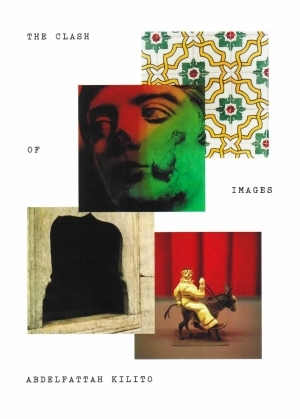Book Review
 Life is a heap of impressions, sensations, dreams.
Life is a heap of impressions, sensations, dreams.
– Abdelfattah Kilito
The Clash of Images, a story collection by Abdelfattah Kilito, translated by Robyn Creswell, offers a series of snapshot-like events from coastal Morocco during the technological onslaught of the 20th century. How does a culture devoid of images—forbidden, in fact, from attempting to copy what God alone creates—retain its identity in a time of passport photos, comic books, cinema, and the ever-advancing digital age? Kilito’s style is that of a ponderous memoir with a capacity for drawing up and revealing the cultural conflicts that bunch beneath the surface of his stories. From the Islamic classroom to the public bath, summer camp where singing substitutes for food, or a crowded cinema playing spaghetti westerns, Kilito chips away at what we think we know about growing up Arab and Muslim.
This eloquent glimpse into Moroccan boyhood stirs the Western reader in many different, often conflicting, ways. In “Revolt in the Msid” we encounter a pact between father and teacher, as a boy is first handed over to the rigors of Quranic instruction.
…it was necessary to say it—about the msid, that place where knowledge is acquired… It was necessary to speak of it with regret, or with a fierce, retrospective indignation. Necessary to evoke the brutal instructor and the stale pedagogy he foisted on students made to learn… And necessary to speak, in bafflement or scorn, about the complicity of father and instructor, this one saying to that one, the first time he brings his son to the msid: “You, you kill; me, I bury.”
When one student takes a stand against the beatings commonly meted out to those who fail, whether in memorizing scriptures or simply falling asleep, we are stunned by the collective response to this boy—a classic hero in the minds of Westerners. His fellow sufferers wish the instructor to batter down this wicked revolt with such fury as to kill the boy. “Revolt in the Msid,” while concluding with remarkable compassion, leaves the reader picking apart Kilito’s finely wrought sentences, like drawing meat from a bone, seeking any small scrap to appease a new curiosity.
Kilito unspools our frustration, though, in “Cinedays” where a young narrator joins the men to watch “cowboy films,” a label attached to all movies from America. The appeal of a theatre filled with non-English speakers learning about us through our Hollywood images is endearing, and it invokes a sense of pity, as well. The riotous comedy of the projectionist-turned-director and his unspoken promise to spare the crowd tediously boring stretches of dialogue have our cinematic heroes leaping from action scene to action scene in bewilderment: barroom brawl to desert heist to posse chase to, finally, the kiss—that taboo of human intimacy not sanctioned for public display. But it is not the presence of the kiss the young narrator focuses on, but the necessity of it, because he has learned the correct Western story arc and knows when he’s been robbed.
Yet “Cinedays” illustrates the power of those images in uniting the collective human race in Kilito’s description of a movie suddenly interrupted.
The lights came back on and everyone looked at each other, somewhat shyly and shamefacedly, as though waking from a nap that had caught them unawares. While dozing off we all had the same dream, exactly the same. … In the cave whose lights had just come on they were freed of their chains, yet they wanted nothing more than to put the chains back on, to dive back into darkness, lose consciousness of themselves and let their gazes glide over those fleeting, illusory, and deceitful images.
For all its examples of the narrowing gap between Middle Eastern and Western cultures, though, readers will find a woman’s place in these stories inescapably limited. Kilito writes from observation rather than judgment—a truthful accounting of where things stand through his fiction. Nonetheless, the position of women is a disheartening reality that he addresses only lightly, such as in the story “The Wife of R.”
In retrospect one might imagine his wife was a victim of the social system, a system that forced her to lurk behind her own door, forced into this wanton spying, this perversion of knowledge called curiosity.
The Clash of Images is an accessible and well-written commentary on the changing culture in North Africa and the Muslim world as its people struggle to hold onto what they value while confronting the modern challenges to their traditional teachings and sensibilities. These changes are witnessed throughout this work, from an image of the prophet Mohammed in a textbook intended for French students to the modernization of the hammam—public bath—with spigots instead of basins. As Kilito states in his Author’s Note, “perhaps we shall ask ourselves what Arabs lost by entering the age of the image.”
About the Reviewer
Heather Sharfeddin is the author of four novels. Her work has earned starred reviews from Kirkus Reviews and Library Journal, has been honored with an Erick Hoffer Award, as well as the New York and San Francisco Book Festivals and Pacific Northwest Book Sellers Association. Her first novel, Blackbelly, was named one of the top five novels of 2005 by the Portsmouth Harold.
Sharfeddin holds an MFA in writing from Vermont College of Fine Arts and is working on her PhD in Creative Writing. She currently teaches at University of Arkansas at Little Rock.